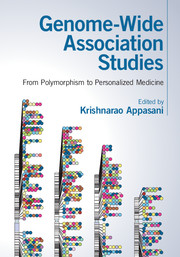Book contents
- Frontmatter
- Dedication
- Contents
- List of contributors
- Forewords
- Preface
- List of abbreviations
- Part I Genome-wide association studies
- Part II Genome-wide studies in disease biology
- Part III Single nucleotide polymorphisms, copy number variants, haplotypes and eQTLs
- 10 Finding SNPs that affect microRNA regulation in disease-associated genomic regions
- 11 From linkage to complex associations: the role of GABRA2 as a risk factor for alcohol use
- 12 Copy number variation in monozygous twins
- 13 Haplotypes of CpG-related SNPs and associations with DNA methylation patterns
- 14 eQTL mapping
- Part IV Next-generation sequencing technology and pharmaco-genomics
- Part V Population genetics and personalized medicine
- Index
- Plate section
- References
13 - Haplotypes of CpG-related SNPs and associations with DNA methylation patterns
from Part III - Single nucleotide polymorphisms, copy number variants, haplotypes and eQTLs
Published online by Cambridge University Press: 18 December 2015
- Frontmatter
- Dedication
- Contents
- List of contributors
- Forewords
- Preface
- List of abbreviations
- Part I Genome-wide association studies
- Part II Genome-wide studies in disease biology
- Part III Single nucleotide polymorphisms, copy number variants, haplotypes and eQTLs
- 10 Finding SNPs that affect microRNA regulation in disease-associated genomic regions
- 11 From linkage to complex associations: the role of GABRA2 as a risk factor for alcohol use
- 12 Copy number variation in monozygous twins
- 13 Haplotypes of CpG-related SNPs and associations with DNA methylation patterns
- 14 eQTL mapping
- Part IV Next-generation sequencing technology and pharmaco-genomics
- Part V Population genetics and personalized medicine
- Index
- Plate section
- References
Summary
Introduction
Many technological advances have greatly facilitated the cataloging of millions of single nucleotide polymorphisms (SNPs). In spite of these, an understanding of the functional implications of single base pair changes remains limited. For example, genome projects including the Human Genome Project, HapMap project (International HapMap Consortium, 2003), and 1000 Genomes project have sequenced approximately 6 giga-base pairs of DNA nucleotides to identify 15 million SNPs (1000 Genomes Project Consortium et al., 2010; Clarke et al., 2012). Accompanying the discovery of novel SNPs is growing recognition of associations between SNPs and human diseases, many through genome-wide association studies (GWAS). However, despite this vast growth in genome databases, mechanistic understanding of how SNPs alter phenotypes is largely unknown.
Recent findings have suggested that links between epigenetic status and genetic variants may underlie the functionality of SNPs. Of the major types of epigenetic processes (Portela and Esteller, 2010), DNA methylation has been most frequently linked to human diseases, including cardiovascular diseases (Ordovas and Smith, 2010), diabetes (Hidalgo et al., 2014), obesity (Milagro et al., 2012), dyslipidemia (Guay et al., 2013), and cancer (Weisenberger 2014). Recently, extensive studies have identified the genetic contribution to DNA methylation. Genetic manipulation in mouse stem cells demonstrated that local sequences regulate DNA methylation in both a necessary and sufficient manner (Lienert et al., 2011). SNPs are commonly occurring and well-documented examples of DNA sequence variation, and SNP regulation of DNA methylation is widespread in humans (Bell et al., 2010; Schalkwyk et al., 2010; Shoemaker et al., 2010; Zhang et al., 2010; Gertz et al., 2011; Qu et al., 2012). For example, 80% of the variation in DNA methylation can be predicted by overall genotype of 40 sequence-dependent autosomal regions (Gertz et al., 2011). Additionally, sequence-based regulation of DNA methylation is flexible, occurring either in cis or in trans (Schalkwyk et al., 2010). Further, methylation-related SNPs have been shown to affect gene expression (Schalkwyk et al., 2010), alternative splicing (Bell et al., 2010), and binding by certain transcription factors (Bell et al., 2010; Paliwal et al., 2013), all of which are potential mechanisms by which SNPs may alter phenotypes.
CpG-related SNPs (CGSs) constitute a group of SNPs with a particular relationship to DNA methylation. By definition, CGSs referred to those SNPs which can change the formation of CpG dinucleotides, which has been established as the primary target site of DNA methylation.
- Type
- Chapter
- Information
- Genome-Wide Association StudiesFrom Polymorphism to Personalized Medicine, pp. 193 - 207Publisher: Cambridge University PressPrint publication year: 2016
References
- 1
- Cited by



